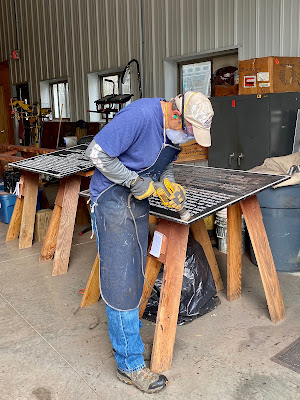On August 30, 1890, almost twenty-eight years after the bloody Battle of Antietam the United States Congress appropriated money for “surveying, locating and preserving the lines of battle of the Army of the Potomac and the Army of Northern Virginia. In 1890 the Antietam Battlefield Board was created under the auspices of the Secretary of War to oversee the work. The original members of the board were Union Colonel John C. Stearns and Confederate Brigadier General Henry Heth. Stearns resigned due to ill health on July 31, 1894. He was replaced by Major George B. Davis, who had enlisted in the First Massachusetts Cavalry at sixteen, and later graduated from West Point, in October 1894. About the same time Jedediah Hotchkiss, was appointed to the board as an "expert topographer" and Brevet Brigadier General Ezra Carmen, who had served with the Thirteenth New Jersey at Antietam, was appointed as a “historical expert”. In August 1895 Major George W. Davis, who had served with the Eleventh Connecticut during the Civil War replaced George B. Davis as board president.
After locating the lines of battle of the Union and Confederate forces, and securing the permission of the War Department, the battlefield board set about marking the various positions of the two armies with cast iron tablets “bearing historical descriptions of the movement of troops”. Carmen, and to a much lesser extent Davis, corresponded with veterans from both sides to obtain information about troop positions to write the text for the tablets. Once the research was completed and the tablet text drafted the War Department let a contract to the Chattanooga Car and Foundry Company, of Chattanooga Tennessee, who was also casting tablets for the Chickamauga Battlefield in northern Georgia, to cast the tablets for Antietam. Tablet production was in full swing in the first four months of 1895. In May 1895 the foundry shipped the first batch of cast iron tablets and 105 smaller markers to Sharpsburg. An additional 43 tablets were shipped in October 1895. In 1896 ninety more tablets were cast and shipped. By October 1897 the work was completed at a cost of $7,865. In total 338 tablets were cast and erected, of which 313 were installed at Antietam, five at Harpers Ferry, five at Shepherdstown, six at South Mountain and nine at Crampton’s Gap. After their work was completed the Antietam Battlefield Board was disbanded. In their final report written on March 18, 1898 it was noted, in reference to the tablets, “with an occasional repainting at small expense they will endure for centuries.”
Tablets Along the Sunken Road (Bloody Lane)
Most of the tablets that were installed in the 1890’s on the fields of battle in Western Maryland and at Harpers Ferry and Shepherdstown are still there. A few have been damaged and/or removed over the years. Some have been replaced by aluminum replicas.
It is unknown how many times the tablets have been repainted in the 126 years since they were erected. In 2016 or 2017 Antietam National Battlefield set up a special program which enabled a select number of volunteers to work under the auspices of the Cultural Resource Division and repaint the tablets.
The first step involves removing the tablets from the field and taking them in to the maintenance warehouse. Some of the original cast iron tablets weigh well over 100 pounds.
After the tablets are unloaded at the warehouse and placed on sawhorses they are wire brushed to remove accumulated dirt, grime, organic matter and old layers of paint. They are the cleaned and primed.
Preparing a Tablet for Repainting.
The primed tablet is first painted with two coats of black paint. Care is taken to ensure the paint is uniformly applied, that all letters and imperfections are covered. and there are no drips or runs in the paint.
After the black paint dries a brayer (a small rubber roller) is used to paint two coats of white paint on the raised letters and the boarder of the tablet. After the white paint dries the tablets are touched up to cover any areas where white paint might have overrun onto the black background.
Once the paint has dried the tablets are put back on their pedestals on the battlefield.
All is done “at small expense” for materials, in hopes the tablets will continue “to endure for centuries” and enable visitors to learn the history of the brave men north and south who fought in the Maryland Campaign and along Antietam Creek on September 17, 1862.
For many of us who are privileged to work on this project I can unequivocally say it is a labor of love.







